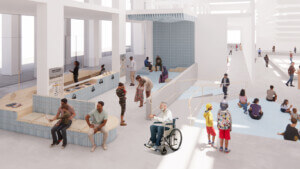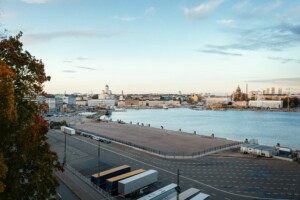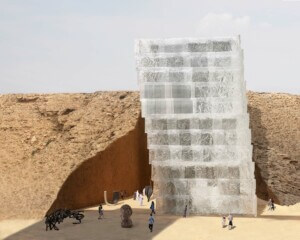This month, The Metropolitan Museum of Art is opening the Met Breuer, replacing the Whitney Museum of American Art that called the Brutalist showpiece home for nearly five decades. Last year, the Whitney moved to Renzo Piano’s building in the Meatpacking District. The Met is renting the Breuer (now the Met Breuer) on an eight-year lease while David Chipperfield works on a new space for contemporary art.
The site of the Met’s latest acquisition, however, has a colourful past, fending off near misses from Graves to Koolhaas and Piano. AN Takes a look at what so nearly could have been.
In 1989, the New York Times ran the headline: “The Whitney Paradox: To Add Is To Subtract.” Such was Paul Goldberger’s distaste for what Michael Graves had originally proposed to lie adjacent to Marcel Breuer‘s building. Indeed, Graves’ Postmodern proposal gave rise to Goldberger questioning: “What value does the Breuer building have, both as a work of architecture unto itself and as a part of the streetscape? And how gingerly, therefore, should it be treated?”
Built in 1966, Marcel Breuer’s Modernist granite building may be the epitome of abstract architecture, having remained detached for so long, shooing away any potential plunderers of its monumental message. Breuer, a Hungarian and product of Gropius’ Bauhaus, went so far as to erect concrete walls to resist interaction with adjacent buildings, keeping them at arm’s length.
Despite it’s introverted nature, the Breuer building, over time, has developed a friendly relationship with its brownstone neighbors, amassing a mutual respect for each other. As Goldberger writes: “The brownstones help the Breuer building appear to exist in a world of its own.”
Graves’s proposed demolition of the brownstones was met with outrage, and was ultimately dropped from consideration.
Koolhaas, in turn, kept the brownstones while adding a contorted growth reaching out of their roofs. “They [the brownstones] were treated as an opportunity to display art within the scale of space for which it was created,” OMA said in its proposal. “The greatly expanded area for the permanent collection will be housed in the existing buildings. Pre-war art displayed in brownstones will recall the original West 8th Street Whitney. Post-war art, usually much bigger, would be displayed in the Breuer building.”
The project was rejected amid post September 11th economic slowdown and the fact that it appeared to loom over the Breuer Building.
Renzo Piano, too, kept the brownstones in his reimagining of the Breuer Whitney.
“The Breuer building is resistant to all attempts to bring it into an urban dialogue along the street, but that alone should not be a reason not to build a work of architecture that attempts, gently and powerfully, to coax it into speaking.” Goldberger wrote in 1989.










